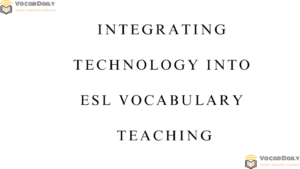Integrating Technology into ESL Vocabulary Teaching
In the digital age, technology offers a wealth of opportunities to enhance ESL vocabulary instruction. By leveraging various digital tools and platforms, educators can create more engaging, interactive, and personalized learning experiences for their students. This article explores effective strategies for integrating technology into ESL vocabulary teaching, highlighting how it can boost student engagement and improve learning outcomes.
Introduction
The integration of technology in ESL vocabulary teaching has transformed the way students learn and interact with new words. From interactive apps to online collaborative tools, technology provides numerous avenues to make vocabulary acquisition more effective and enjoyable. This article delves into various technological approaches that can significantly enhance vocabulary instruction in ESL classrooms.
Interactive Vocabulary Apps
One of the most accessible ways to incorporate technology into vocabulary teaching is through the use of interactive apps. These applications often gamify the learning process, making vocabulary acquisition more engaging and fun for students. Some popular apps include:
- Quizlet: Allows creation of digital flashcards and offers various study modes.
- Duolingo: Provides gamified vocabulary lessons in context.
- Memrise: Uses spaced repetition and mnemonics to aid vocabulary retention.
Encourage students to use these apps for independent practice outside of class time. Many of these apps also offer teacher dashboards, allowing you to track student progress and identify areas needing additional support.
Digital Storytelling
Digital storytelling tools can be powerful for contextualizing vocabulary. Platforms like Storybird or Adobe Spark allow students to create visual stories using new vocabulary words. This creative process not only reinforces word meanings but also helps students understand how to use vocabulary in context.Assign projects where students must incorporate target vocabulary into digital stories. This approach combines vocabulary learning with digital literacy skills, making it particularly valuable for modern ESL learners.
Virtual Reality and Augmented Reality
Virtual Reality (VR) and Augmented Reality (AR) technologies offer immersive experiences that can significantly enhance vocabulary learning. These technologies can provide visual and contextual cues that make abstract concepts more concrete and memorable.
- Use VR applications to transport students to different environments where they can learn and practice vocabulary in context.
- Employ AR apps that overlay information on real-world objects, providing instant translations or definitions.
While these technologies might require more resources, they offer unparalleled immersive experiences that can dramatically improve vocabulary retention and understanding.
Online Collaborative Tools
Collaborative online platforms can facilitate group vocabulary learning activities. Tools like Padlet, Jamboard, or Miro allow students to work together on vocabulary tasks in real-time, even in remote learning settings.Create virtual vocabulary walls where students can post new words they’ve learned, along with definitions, example sentences, or images. This collaborative approach encourages peer learning and provides a visual representation of the class’s collective vocabulary growth.
Adaptive Learning Platforms
Adaptive learning technologies use algorithms to adjust the difficulty and content of vocabulary exercises based on individual student performance. Platforms like DuoLingo or Rosetta Stone adapt to each student’s pace and level, providing a personalized learning experience.Incorporate these platforms into your curriculum to provide students with tailored vocabulary practice. The data generated by these systems can also offer valuable insights into student progress and areas needing additional focus.
Multimedia Vocabulary Journals
Encourage students to maintain digital vocabulary journals using multimedia tools. Platforms like OneNote or Evernote allow students to create rich entries for new words, including:
- Text definitions and example sentences
- Images or drawings
- Audio pronunciations
- Video clips demonstrating usage
This multimedia approach caters to different learning styles and creates a more comprehensive understanding of new vocabulary.
Social Media Integration
Leverage social media platforms to create engaging vocabulary learning experiences. For instance:
- Use Instagram for a “Word of the Day” feature, where students post images representing new vocabulary words.
- Create a class Twitter account to share short sentences using target vocabulary.
- Use TikTok for brief vocabulary explanation videos or challenges.
This approach not only makes learning more engaging but also helps students see how vocabulary is used in real-world digital communication.
Vocabulary Games and Quizzes
Utilize online quiz and game creation tools to make vocabulary practice more interactive and fun. Platforms like Kahoot!, Quizizz, or Wordwall allow you to create custom vocabulary games and quizzes.These tools often provide real-time feedback and generate reports on student performance, making them valuable for both formative assessment and engaging practice sessions.
Corpus Tools for Advanced Learners
For more advanced ESL students, introduce corpus tools like the Corpus of Contemporary American English (COCA) or the British National Corpus (BNC). These resources allow students to explore word usage in authentic contexts across various genres and time periods.Teach students how to use these tools to investigate collocations, frequency, and contextual usage of vocabulary words, fostering a deeper understanding of language patterns.
Podcasts and Audio Resources
Incorporate podcasts and audio resources into your vocabulary instruction. Platforms like ESL Pod or VoiceTube offer content specifically designed for ESL learners, often with transcripts and vocabulary explanations.
Assign listening tasks that focus on identifying and understanding target vocabulary in context. This approach not only enhances vocabulary skills but also improves listening comprehension.
By integrating these technological tools and strategies into ESL vocabulary instruction, educators can create a more dynamic, personalized, and effective learning environment. Technology offers the flexibility to cater to diverse learning styles and proficiency levels, making vocabulary acquisition a more engaging and successful process for all students.
For more innovative ideas on integrating technology into ESL vocabulary teaching, visit www.https://vocabdailyofficial.blogspot.com/. Don’t forget to explore our comprehensive vocabulary workbook, which includes digital components to support technology-enhanced learning, available at https://shorturl.at/0a0Qc.


Leave a Reply